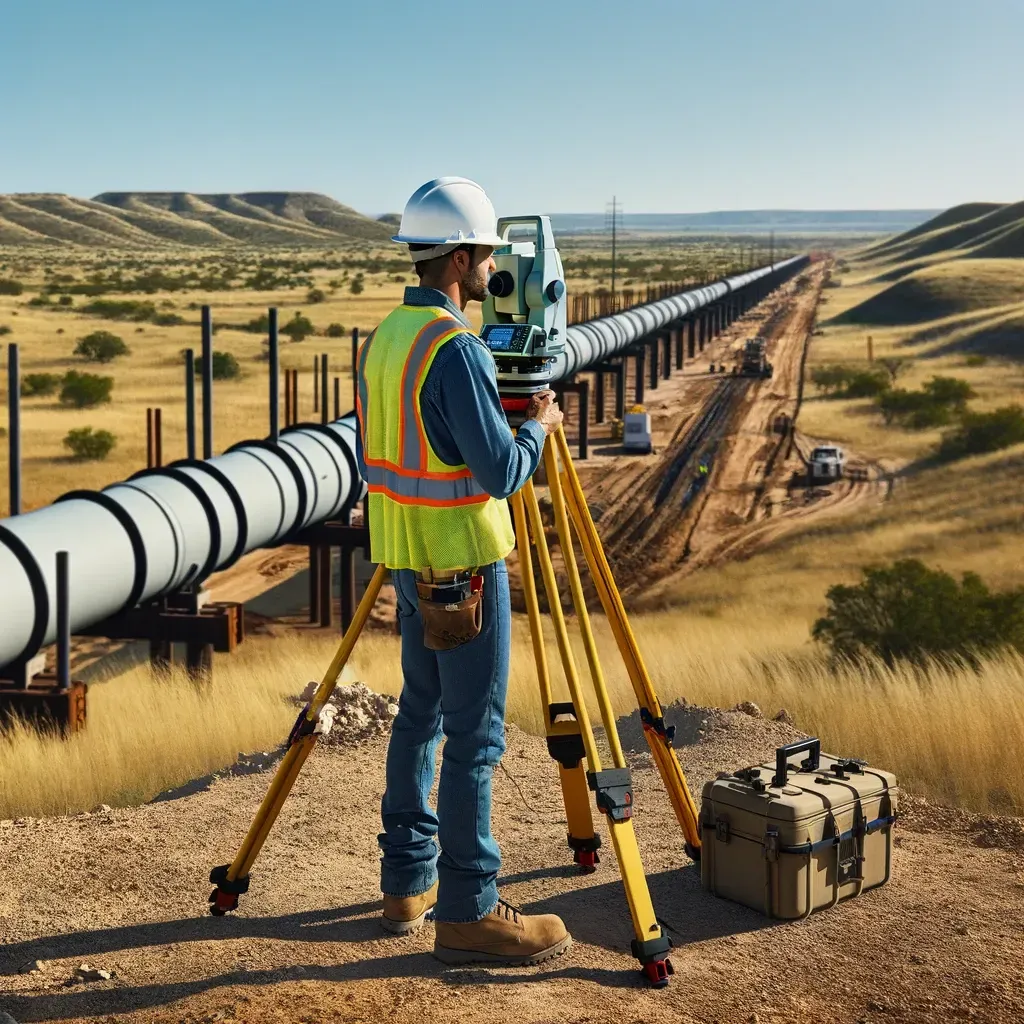Surveying Texas Since 1980 Family Owned, Customer Devoted | Firm #10045400 | 281-556-6918
Thank You!
Thank you for requesting a bid! We'll have a team member call you soon to discuss your needs.
Delivering Land Surveys with Attention to Detail
George Owens

I have worked with many surveying companies, but South Texas Surveying stands out for their exceptional professionalism, attention to detail, and commitment to their clients.
Kim Wexler

Their accurate and thorough surveys make my job a lot easier, their ability to communicate effectively with all parties involved is commendable. I highly recommend South Texas Surveying.
James Cart

As a new homeowner, I was thoroughly impressed with the professional service provided by South Texas Surveying. I high recommend their services to any one buying a home in Houston.
Read Our Latest Blog

Pipeline Land Surveys: Key Benefits and Why They Matter
"Purchasing large acreage land is a significant investment, whether for agricultural, residential, or commercial purposes." - Chris Evans
Pipeline Land Surveys:
Key Benefits and Why They Matter
Pipeline projects are crucial for transporting oil, gas, and other resources across vast distances, often crossing private and public lands. However, the success of these projects depends heavily on thorough planning and meticulous attention to detail. One of the most critical steps in this process is conducting a pipeline land survey. These surveys are essential for ensuring the safety, compliance, and success of pipeline installations. This article explores the key benefits of pipeline land surveys and why they are vital for any pipeline project.
Ensuring Accurate Land Boundaries
One of the primary benefits of a pipeline land survey is the precise definition of land boundaries. When laying pipelines, it's crucial to know exactly where the property lines are to avoid encroaching on neighboring lands or violating property rights. A land survey provides a detailed map of the area, clearly marking the boundaries and ensuring that the pipeline stays within the designated right-of-way.
Accurate boundary delineation is not only important for legal reasons but also for maintaining good relationships with landowners. Any disputes over land boundaries can lead to costly delays, legal challenges, and strained relationships with the local community. A thorough pipeline land survey helps prevent these issues by clearly defining the area where the pipeline can be safely and legally installed.
Identifying Easements and Rights-of-Way
Easements and rights-of-way are critical considerations in pipeline projects. These legal agreements grant the pipeline company the right to use specific portions of land for pipeline installation and maintenance. A pipeline land survey identifies all existing easements and rights-of-way on the property, ensuring that the pipeline route does not interfere with other land uses or violate any legal agreements.
In addition to identifying existing easements, the survey helps establish new rights-of-way necessary for the pipeline project. This process involves negotiating with landowners and ensuring that all legal requirements are met before construction begins. Properly established easements and rights-of-way are essential for avoiding legal disputes and ensuring the long-term viability of the pipeline.
Assessing Topography and Terrain
The topography and terrain of the land play a significant role in determining the feasibility and safety of a pipeline project. A pipeline land survey provides detailed information about the elevation, slopes, and natural features of the land. This data is crucial for designing a pipeline route that minimizes environmental impact and avoids areas prone to erosion, landslides, or flooding.
Understanding the topography also helps engineers plan the pipeline's depth and alignment, ensuring that it follows the safest and most efficient path. For example, in hilly or mountainous regions, the survey can identify the best routes to avoid steep inclines that could complicate construction or maintenance. Similarly, in flat areas, the survey can reveal flood-prone zones that should be avoided or require special design considerations.
Detecting Environmental Hazards and Sensitive Areas
Environmental protection is a critical concern in pipeline projects. A pipeline land survey helps identify potential environmental hazards and sensitive areas, such as wetlands, protected habitats, and water bodies. Detecting these areas early in the planning process allows for the development of strategies to minimize environmental impact and comply with environmental regulations.
For instance, if the survey reveals the presence of endangered species or critical habitats, the pipeline route can be adjusted to avoid these areas. Similarly, if the land includes wetlands or water bodies, the survey can inform the design of measures to prevent contamination and protect water quality. By addressing environmental concerns proactively, pipeline companies can avoid costly fines, legal challenges, and reputational damage.
Ensuring Compliance with Regulatory Requirements
Pipeline projects are subject to a wide range of federal, state, and local regulations, many of which pertain to land use, environmental protection, and safety standards. A pipeline land survey ensures that the project complies with all relevant regulations by providing detailed documentation of the land’s characteristics and the proposed pipeline route.
This documentation is crucial for obtaining the necessary permits and approvals from regulatory agencies. It also serves as evidence of compliance in case of inspections or audits. By ensuring regulatory compliance from the outset, pipeline companies can avoid costly delays, fines, and legal challenges that could jeopardize the project.
Facilitating Landowner Negotiations
Pipeline projects often require negotiations with multiple landowners to secure the necessary rights-of-way. A pipeline land survey provides valuable information that can facilitate these negotiations, including detailed maps, boundary lines, and the proposed pipeline route. This information helps landowners understand the impact of the pipeline on their property and can lead to more productive and amicable negotiations.
In some cases, the survey may reveal that the pipeline route needs to be adjusted to accommodate landowner concerns or to avoid sensitive areas. Having this information early in the negotiation process allows for more flexible and cooperative solutions, reducing the risk of disputes and delays.
Minimizing Project Costs and Delays
A thorough pipeline land survey helps identify potential challenges and obstacles that could increase project costs or cause delays. By mapping out the land and its features, the survey allows engineers to plan the most efficient and cost-effective pipeline route, avoiding areas that would require expensive mitigation measures or pose significant construction challenges.
For example, if the survey reveals that a proposed route crosses difficult terrain or environmentally sensitive areas, the project team can explore alternative routes that may be easier and cheaper to construct. Similarly, identifying potential issues early in the process allows for better budgeting and resource allocation, reducing the likelihood of unexpected costs or delays during construction.
Enhancing Safety and Risk Management
Safety is a top priority in any pipeline project, and a pipeline land survey plays a critical role in ensuring the safety of the pipeline and the surrounding area. By providing detailed information about the land's characteristics, the survey helps engineers design a pipeline that minimizes risks, such as leaks, spills, or explosions.
The survey also identifies potential hazards, such as unstable soil, fault lines, or flood-prone areas, that could pose risks to the pipeline's integrity. By addressing these hazards in the design and construction phases, pipeline companies can reduce the likelihood of accidents and improve the overall safety of the pipeline.
Supporting Future Maintenance and Inspections
Once the pipeline is installed, regular maintenance and inspections are essential to ensure its continued safe operation. A pipeline land survey provides a detailed record of the pipeline's location, depth, and surrounding features, which is invaluable for future maintenance and inspections.
This information helps maintenance teams locate the pipeline quickly and accurately, reducing the time and effort required for inspections and repairs. It also ensures that any maintenance activities are conducted within the correct boundaries and in compliance with all relevant regulations.
Protecting Property Values
Pipeline projects can have a significant impact on the value of the land they cross. A pipeline land survey helps protect property values by ensuring that the pipeline is installed within the designated right-of-way and that all legal and environmental considerations are addressed.
By clearly defining the pipeline's location and ensuring compliance with all regulations, the survey helps maintain the value of the surrounding land. This is particularly important for landowners who may be concerned about the impact of the pipeline on their property's marketability or long-term value.
Conclusion
Pipeline land surveys are an essential component of any successful pipeline project. They provide critical information about land boundaries, topography, environmental hazards, and regulatory compliance, helping to ensure the safety, efficiency, and legal viability of the pipeline. By investing in a thorough land survey, pipeline companies can minimize risks, reduce costs, and protect the interests of all stakeholders involved. Whether you are a landowner, developer, or pipeline company, understanding the importance of pipeline land surveys is key to ensuring the success and sustainability of your project.
FAQs
1. What is a pipeline land survey?
A pipeline land survey is a detailed examination of the land where a pipeline is proposed to be installed. It includes mapping boundaries, identifying easements, assessing topography, and detecting environmental hazards, all of which are crucial for the safe and legal installation of the pipeline.
2. Why are easements important in pipeline projects?
Easements grant legal rights to use a portion of land for specific purposes, such as pipeline installation. Identifying and securing easements is essential to ensure that the pipeline does not interfere with other land uses and complies with legal requirements.
3. How does a pipeline land survey help in environmental protection?
A pipeline land survey identifies sensitive environmental areas, such as wetlands or protected habitats, allowing the pipeline route to be adjusted to minimize environmental impact and comply with environmental regulations.
4. Can a pipeline land survey prevent legal disputes?
Yes, a pipeline land survey helps prevent legal disputes by clearly defining land boundaries, identifying easements, and ensuring compliance with regulations. This clarity helps avoid conflicts with landowners and regulatory agencies.
5. How does topography affect pipeline installation?
Topography impacts the feasibility and safety of pipeline installation. A survey assesses the land’s elevation, slopes, and natural features, helping engineers design a pipeline route that avoids challenging terrain and minimizes environmental impact.
6. What role does a pipeline land survey play in future maintenance?
A pipeline land survey provides a detailed record of the pipeline’s location and surrounding features, which is essential for accurate and efficient future maintenance and inspections, ensuring the pipeline's long-term safety and reliability.
Contact Us
Email: [email protected]
Office Address: 11281 Richmond Ave
BLDG J, Suite 101,
Houston, TX 77082
Office Hours: Mon – Fri 8:00am – 5:00pm
Office Phone Number: 281-556-6918
11281 Richmond Ave
BLDG J, Suite 101,
Houston, TX 77082
Firm Number: 10045400
Resources
© Copyright 2024 South Texas Surveying Associates
